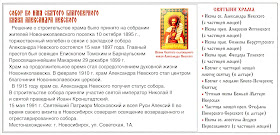Page
▼
April 15, 2012
0173 RUSSIA (Novosibirsk Oblast) - An Alexander Nevsky Cathedral in the heart of Siberia
Today celebrate Easter (the Resurrection of Jesus, Son of God) over 300 million Orthodox Christians worldwide, primarily in Belarus, Bulgaria, Cyprus, Georgia, Greece, Macedonia, Moldova, Montenegro, Romania, Russia, Serbia and Ukraine (the order is alphabetical), but also in many other countries in the world where inhabit smaller communities. Most live in Russia, where over 70% of the population is Christian Orthodox (nearly 100 million). So my choice for today was stopped on a church in Russia, but not on the old one from the European Russia, as would be expected, but on a new one, located in Siberia, more precisely in Novosibirsk.
Founded in 1893 at the future site of a Trans-Siberian Railway bridge crossing the river Ob, Novosibirsk (initially named Novonikolayevsk, in honor of both Saint Nicholas and the reigning Tsar Nicholas II) is today the third most populous city in Russia, after Moscow and Saint Petersburg. Rapid growth and industrialization has brought to the city the nickname "Chicago of Siberia".
One of the first stone constructions in Novonikolayevsk was Alexander Nevsky church, built in 1896-1899 in Neo-Byzantine style, influenced by the design of Church of Our Lady the Merciful in St.Petersburg, erected a few years earlier. In 1915 it became a cathedral, but in 1937 it was closed, and in 1989 was restituted to the Russian Orthodox Church.
Even if the church was built after the death of Tsar Alexander III (r. 1881-1894), she greatly respected his taste. Nearly all of the 5,000 churches attributed to this tzar belonged to the late 19th century variant of Russian Revival, as a reaction against to 18th century baroque and neoclassicism, to which he displayed a clear aversion. Indeed, Byzantine architecture isn’t Russian Revival, but was an acceptable "middle road".
The patron saint, Alexander Nevsky (1220-1263) was, as the Prince of Novgorod and Grand Prince of Vladimir, a key figure of medieval Rus, being proclaimed Saint of the Russian Orthodox Church in 1547. For his military victories over the German, and Swedish invaders, is regarded as patron saint of soldier and borders of Russia. Probably not incidentally was chosen as patron saint to many cathedrals located (outside those of capitals Moskow and Saint Petersburg) to the edge of the empire, such as the ones from Baku (Azerbaijan), Łódź and Warsaw (Poland), Tallinn (Estonia), Tiflis (Georgia), Kamianets-Podilskyi and Yalta (Ukraine), or even beyond, in Belgrade (Serbia), Sofia (Bulgaria) or Prešov (Slovakia).
As you can see, the stamp doesn't exist, because this postcard isn't a postcard in the true sense, because you can't write on it and can be shipped only in envelope. And only to the Russian speakers. On the back is a brief history of the cathedral (on left) and a list of the icons which are inside the church (on right).
sender: Svetlana Martynova (direct swap)
sent from Novosibirsk (Russia), on 25.03.2012


No comments:
Post a Comment